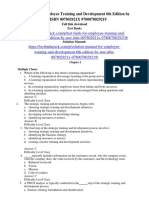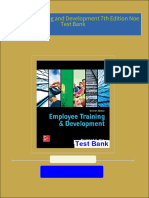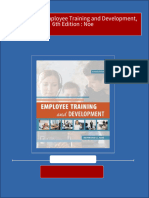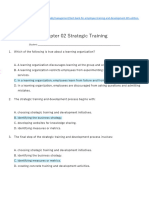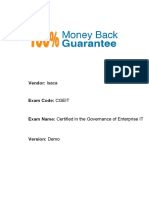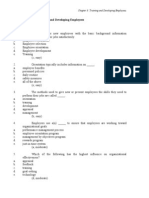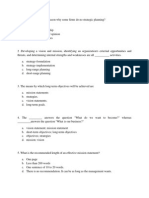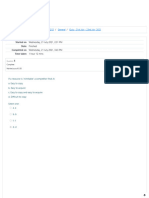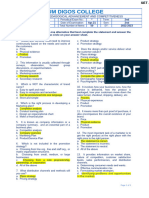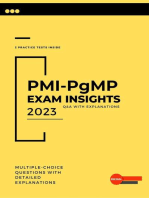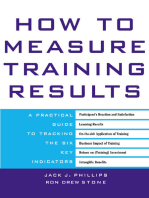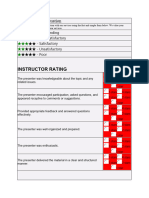Employee Training and Development 7th Ed
Employee Training and Development 7th Ed
Uploaded by
jgmaranohCopyright:
Available Formats
Employee Training and Development 7th Ed
Employee Training and Development 7th Ed
Uploaded by
jgmaranohOriginal Title
Copyright
Available Formats
Share this document
Did you find this document useful?
Is this content inappropriate?
Copyright:
Available Formats
Employee Training and Development 7th Ed
Employee Training and Development 7th Ed
Uploaded by
jgmaranohCopyright:
Available Formats
Full file at https://testbankuniv.
eu/Employee-Training-and-Development-7th-Edition-Noe-Test-Bank
Page 1
Chapter Two
Strategic Training
OBJECTIVES
1. Discuss how business strategy influences the type and amount of training in a company.
2. Describe the strategic training and development process.
3. D”s—uss “ow a —ompany’s staff”ng and “uman resour—e plann”ng strategies influence training.
4. Explain the training needs created by concentration, internal growth, external growth, and
disinvestment business strategies.
5. Discuss the advantages and disadvantages of centralizing the training function.
6. Explain a corporate university and its benefits.
7. Discuss the strengths of a business-embedded learning function.
8. Discuss how to create a learning or training brand and why it is important.
9. Develop a marketing campaign for a training course or program.
MULTIPLE CHOICE
2.1. Which of the following is true about a learning organization?
a. A learning organization discourages learning at the group and organizational levels.
b. A learning organization restricts employees from experimenting with products and services.
c. In a learning organization, employees learn from failure and from successes.
d. In a learning organization, employees are discouraged from asking questions and admitting
mistakes.
Answer: c
Difficulty: easy
Learning objective: 1
2.2. The strategic training and development process begins with _____.
a. choosing strategic training and development initiatives
b. identifying the business strategy
Copyr”g“t © 2017 M—Graw-Hill Education. All rights reserved. No reproduction or distribution without the prior written consent of
McGraw-Hill Education.
Full file at https://testbankuniv.eu/Employee-Training-and-Development-7th-Edition-Noe-Test-Bank
Full file at https://testbankuniv.eu/Employee-Training-and-Development-7th-Edition-Noe-Test-Bank
Page 2
c. developing websites for knowledge sharing
d. identifying measures or metrics
Answer: b
Difficulty: easy
Learning objective: 2
2.3. The final step of the strategic training and development process involves _____.
a. choosing strategic training and development initiatives
b. identifying the business strategy
c. identifying measures or metrics
d. creating concrete training and development activities
Answer: c
Difficulty: easy
Learning objective: 2
2.4 _____ typically includes information on the customers served, why the company exists, what the
company does, the value received by the customers, and the technology used.
a. Balanced scorecard
b. Vision
c. Mission
d. Code of conduct
Answer: c
Difficulty: easy
Learning objective: 2
2.5. Which of the following is not one of the four major components of the balanced scorecard?
a. Customers
b. Internal business processes
c. Sustainability
d. Financial
Copyr”g“t © 2017 M—Graw-Hill Education. All rights reserved. No reproduction or distribution without the prior written consent of
McGraw-Hill Education.
Full file at https://testbankuniv.eu/Employee-Training-and-Development-7th-Edition-Noe-Test-Bank
Full file at https://testbankuniv.eu/Employee-Training-and-Development-7th-Edition-Noe-Test-Bank
Page 3
Answer: c
Difficulty: medium
Learning objective: 2
2.6. A SWOT analysis is typically conducted in the _____ step of the strategic training and development
process.
a. business strategy formulation and identification
b. strategic training and development initiatives
c. training and development activities
d. measures or metrics identification
Answer: a
Difficulty: easy
Learning objective: 2
2.7. _____ ”nvolves exam”n”ng a —ompany’s operat”ng env”ronment to ”dent”fy opportun”t”es and t“reats.
a. Internal analysis
b. Gap analysis
c. External analysis
d. Pareto analysis
Answer: c
Difficulty: easy
Learning objective: 2
Copyr”g“t © 2017 M—Graw-Hill Education. All rights reserved. No reproduction or distribution without the prior written consent of
McGraw-Hill Education.
Full file at https://testbankuniv.eu/Employee-Training-and-Development-7th-Edition-Noe-Test-Bank
Full file at https://testbankuniv.eu/Employee-Training-and-Development-7th-Edition-Noe-Test-Bank
Page 4
2.8. Which of the following is true with regard to SWOT analysis?
a. In a SWOT analys”s, external analys”s attempts to ”dent”fy t“e —ompany’s strengt“s and
weaknesses.
b. A SWOT analysis represents the strategy believed to be the best alternative to achieve the
company goals.
c. A SWOT analysis is typically conducted in the strategic training and development initiatives
step of the strategic training and development process.
d. A SWOT analysis provides a company the information needed to generate several alternative
business strategies and make a strategic choice.
Answer: d
Difficulty: medium
Learning objective: 2
2.9. Business-level outcomes chosen to measure the overall value of training or learning initiatives are
referred to as _____.
a. values
b. goals
c. business strategies
d. metrics
Answer: d
Difficulty: easy
Learning objective: 2
2.10. The _____ considers four different perspectives: customer, internal, innovation and learning, and
financial.
a. SWOT analysis
b. value chain analysis
c. BCG matrix
d. balanced scorecard
Answer: d
Copyr”g“t © 2017 M—Graw-Hill Education. All rights reserved. No reproduction or distribution without the prior written consent of
McGraw-Hill Education.
Full file at https://testbankuniv.eu/Employee-Training-and-Development-7th-Edition-Noe-Test-Bank
Full file at https://testbankuniv.eu/Employee-Training-and-Development-7th-Edition-Noe-Test-Bank
Page 5
Difficulty: easy
Learning objective: 2
2.11. _____ refers to t“e —ompany’s de—”s”ons regard”ng w“ere to find employees, how to select them,
and the desired mix of employee skills and statuses.
a. Concentration strategy
b. Staffing strategy
c. External growth strategy
d. Disinvestment strategy
Answer: b
Difficulty: easy
Learning objective: 3
Copyr”g“t © 2017 M—Graw-Hill Education. All rights reserved. No reproduction or distribution without the prior written consent of
McGraw-Hill Education.
Full file at https://testbankuniv.eu/Employee-Training-and-Development-7th-Edition-Noe-Test-Bank
Full file at https://testbankuniv.eu/Employee-Training-and-Development-7th-Edition-Noe-Test-Bank
Page 6
2.12. Which of the following is not one of the major business strategies discussed in the text?
a. Internal growth
b. External growth
c. Divestment
d. Product differentiation
Answer: d
Difficulty: medium
Learning objective: 4
2.13. Companies that emphasize innovation and creativity are labeled as _____.
a. clubs
b. academies
c. fortresses
d. baseball teams
Answer: d
Difficulty: easy
Learning objective: 3
2.14. In _____ financial and other resources are not available for development, so companies tend to rely
on hiring talent from the external labor market.
a. clubs
b. fortresses
c. baseball teams
d. academies
Answer: b
Difficulty: easy
Learning objective: 3
2.15. Uniqueness refers to _____.
a. employee potential to improve company effectiveness and efficiency
b. the extent to which training and learning is centralized in an organization
Copyr”g“t © 2017 M—Graw-Hill Education. All rights reserved. No reproduction or distribution without the prior written consent of
McGraw-Hill Education.
Full file at https://testbankuniv.eu/Employee-Training-and-Development-7th-Edition-Noe-Test-Bank
Full file at https://testbankuniv.eu/Employee-Training-and-Development-7th-Edition-Noe-Test-Bank
Page 7
c. the extent to which employees are rare, specialized, and not highly available in the labor
market
d. the picture of the future an organization wants to achieve
Answer: c
Difficulty: medium
Learning objective: 3
2.16. Job-based employees are characterized by _____.
a. high value and high uniqueness
b. high value and low uniqueness
c. low value and low uniqueness
d. low value and high uniqueness
Answer: b
Difficulty: easy
Learning objective: 3
2.17. Which of the following positions is characterized by high value and low uniqueness?
a. Lab technician
b. Scientist
c. Secretarial staff
d. Legal adviser
Answer: a
Difficulty: medium
Learning objective: 3
2.18. Companies adopting a _____ strategy need to train employees in job-search skills and to focus on
cross-training their remaining employees.
a. concentration
b. disinvestment
c. external growth
d. internal growth
Copyr”g“t © 2017 M—Graw-Hill Education. All rights reserved. No reproduction or distribution without the prior written consent of
McGraw-Hill Education.
Full file at https://testbankuniv.eu/Employee-Training-and-Development-7th-Edition-Noe-Test-Bank
Full file at https://testbankuniv.eu/Employee-Training-and-Development-7th-Edition-Noe-Test-Bank
Page 8
Answer: b
Difficulty: easy
Learning objective: 4
2.19. A(n) _____ strategy focuses on new market and product development, innovation, and joint
ventures.
a. disinvestment
b. privatization
c. external growth
d. internal growth
Answer: d
Difficulty: easy
Learning objective: 4
2.20. Development of an organizational culture that values creative thinking and analysis is characteristic
of a company adopting a(n) _____ strategy.
a. concentration
b. disinvestment
c. internal growth
d. external growth
Answer: c
Difficulty: easy
Learning objective: 4
Copyr”g“t © 2017 M—Graw-Hill Education. All rights reserved. No reproduction or distribution without the prior written consent of
McGraw-Hill Education.
Full file at https://testbankuniv.eu/Employee-Training-and-Development-7th-Edition-Noe-Test-Bank
Full file at https://testbankuniv.eu/Employee-Training-and-Development-7th-Edition-Noe-Test-Bank
Page 9
2.21. Which of the following is true of centralized training?
a. A centralized training function helps drive stronger alignment with business strategy.
b. Training and development programs, resources, and professionals are housed in a number of
different locations.
c. A centralized training function hinders the development of a common set of metrics or
scorecards.
d. A centralized training function is largely ineffective during times of change.
Answer: a
Difficulty: medium
Learning objective: 5
2.22. Which of the following is true of the business-embedded (BE) learning function?
a. The BE function is customer-focused.
b. A BE training function views trainees as marketers.
c. A BE training function does not guarantee that training will improve performance.
d. Training functions organized by the BE model do not involve line managers.
Answer: a
Difficulty: medium
Learning objective: 7
2.23. Justin Mason, a product manager working in a manufacturing firm, is highly anxious about change.
When the top management of Mason's firm made it mandatory for all product managers to
undergo skills training, he told his superior that he would be uncomfortable with the process. He
added that he was certain of not being able to cope with the new developments. In this instance,
Justin is demonstrating _____.
a. indifference to change
b. uniqueness
c. resistance to change
d. loss of control
Answer: c
Copyr”g“t © 2017 M—Graw-Hill Education. All rights reserved. No reproduction or distribution without the prior written consent of
McGraw-Hill Education.
Full file at https://testbankuniv.eu/Employee-Training-and-Development-7th-Edition-Noe-Test-Bank
Full file at https://testbankuniv.eu/Employee-Training-and-Development-7th-Edition-Noe-Test-Bank
Page 10
Difficulty: hard
Learning objective:
2.24. _____ relates to managers’ and employees’ a–”l”ty to o–ta”n and d”str”–ute valua–le resour—es su—“
as data, information, or money.
a. Power
b. Control
c. Vision
d. Outsourcing
Answer: b
Difficulty: easy
Learning objective:
Copyr”g“t © 2017 M—Graw-Hill Education. All rights reserved. No reproduction or distribution without the prior written consent of
McGraw-Hill Education.
Full file at https://testbankuniv.eu/Employee-Training-and-Development-7th-Edition-Noe-Test-Bank
Full file at https://testbankuniv.eu/Employee-Training-and-Development-7th-Edition-Noe-Test-Bank
Page 11
2.25. Which of the follow”ng ”s not one of t“e major —“ange-related pro–lems t“at need to –e
addressed before the implementation of new training practices?
a. Resistance to change
b. Loss of control
c. Power imbalance
d. Training-business strategy incongruence
Answer: d
Difficulty: easy
Learning objective:
2.26. Which of the following is not one of the major reasons organizations outsource training?
a. Potential cost savings
b. Desire for greater control
c. Time savings
d. Desire to access best practices
Answer: b
Difficulty: easy
Learning objective:
TRUE-FALSE
2.27. Learning organizations emphasize that learning occurs not only at the individual employee level
but also at the group and organizational levels.
Answer: true
Difficulty: easy
Learning objective: 1
2.28. In learning organizations, there is an understanding that failure provides important information.
Answer: true
Copyr”g“t © 2017 M—Graw-Hill Education. All rights reserved. No reproduction or distribution without the prior written consent of
McGraw-Hill Education.
Full file at https://testbankuniv.eu/Employee-Training-and-Development-7th-Edition-Noe-Test-Bank
Full file at https://testbankuniv.eu/Employee-Training-and-Development-7th-Edition-Noe-Test-Bank
Page 12
Difficulty: easy
Learning objective: 1
2.29. Tacit knowledge developed through experience and shared through interactions between
employees is easy to imitate.
Answer: false
Difficulty: easy
Learning objective: 1
2.30. Explicit knowledge is thought to have a stronger impact on helping organizations achieve a
competitive advantage than tactic knowledge.
Answer: false
Difficulty: medium
Learning objective: 1
2.31. The first step in the strategic training and development process is to identify metrics to determine
if training will be successful.
Answer: false
Difficulty: easy
Learning objective: 2
2.32. Internal analysis involves identifying opportunities and threats.
Answer: false
Difficulty: easy
Learning objective: 2
2.33. Strateg”— tra”n”ng and development ”n”t”at”ves vary –y —ompany depend”ng on a —ompany’s
industry, goals, resources, and capabilities.
Copyr”g“t © 2017 M—Graw-Hill Education. All rights reserved. No reproduction or distribution without the prior written consent of
McGraw-Hill Education.
Full file at https://testbankuniv.eu/Employee-Training-and-Development-7th-Edition-Noe-Test-Bank
Full file at https://testbankuniv.eu/Employee-Training-and-Development-7th-Edition-Noe-Test-Bank
Page 13
Answer: true
Difficulty: easy
Learning objective: 2
2.34. Emphasis on the creation of intellectual capital and the movement toward high-performance work
systems using teams has resulted in employees performing many roles once reserved for
management.
Answer: true
Difficulty: easy
Learning objective: 3
2.35. From a strateg”— perspe—t”ve, d”vers”fy t“e learn”ng portfol”o refers to prov”d”ng strateg”— d”vers”ty
tra”n”ng to en“an—e a —ompany’s —ompet”t”ve advantage.
Answer: false
Difficulty: medium
Learning objective: 2
2.36. Skill-–ased pay systems –ase employees’ pay on w“at sk”lls t“ey are us”ng for t“e”r —urrent jo–s
rather than the number of skills they are competent in.
Answer: false
Difficulty: easy
Learning objective: 3
2.37. The CEO of a company is responsible for setting a clear direction for learning.
Answer: true
Difficulty: easy
Learning objective: 3
Copyr”g“t © 2017 M—Graw-Hill Education. All rights reserved. No reproduction or distribution without the prior written consent of
McGraw-Hill Education.
Full file at https://testbankuniv.eu/Employee-Training-and-Development-7th-Edition-Noe-Test-Bank
Full file at https://testbankuniv.eu/Employee-Training-and-Development-7th-Edition-Noe-Test-Bank
Page 14
2.38. Line managers spend less time managing individual performance and developing employees than
midlevel managers or executives do.
Answer: false
Difficulty: easy
Learning objective: 3
2.39. In highly integrated businesses, training is likely to include rotating employees between jobs in
different businesses.
Answer: true
Difficulty: easy
Learning objective: 1
2.40. For companies in an unstable or recessionary business environment, training programs focus more
on correcting skill deficiencies rather than preparing staff for new assignments.
Answer: true
Difficulty: easy
Learning objective: 1
2.41. Companies that adopt state-of-the-art HRM practices realize higher levels of performance than
firms that do not.
Answer: true
Difficulty: easy
Learning objective: 1
2.42. Uniqueness refers to employee potential to improve company effectiveness and efficiency.
Answer: false
Difficulty: easy
Copyr”g“t © 2017 M—Graw-Hill Education. All rights reserved. No reproduction or distribution without the prior written consent of
McGraw-Hill Education.
Full file at https://testbankuniv.eu/Employee-Training-and-Development-7th-Edition-Noe-Test-Bank
Full file at https://testbankuniv.eu/Employee-Training-and-Development-7th-Edition-Noe-Test-Bank
Page 15
Learning objective: 3
2.43. Job-based employees are likely to receive less training than knowledge-based employees.
Answer: true
Difficulty: easy
Learning objective: 3
2.44. Training for contract employees would focus on sharing expertise and team training.
Answer: false
Difficulty: medium
Learning objective: 3
Copyr”g“t © 2017 M—Graw-Hill Education. All rights reserved. No reproduction or distribution without the prior written consent of
McGraw-Hill Education.
Full file at https://testbankuniv.eu/Employee-Training-and-Development-7th-Edition-Noe-Test-Bank
Full file at https://testbankuniv.eu/Employee-Training-and-Development-7th-Edition-Noe-Test-Bank
Page 16
2.45. Companies should generally avoid involving unions in retraining and productivity-improvement
efforts.
Answer: false
Difficulty: easy
Learning objective: 3
2.46. A centralized training function not only hampers the streamlining of processes but also denies the
company a cost advantage in purchasing training from vendors.
Answer: false
Difficulty: easy
Learning objective: 5
2.47. Companies pursuing an external growth strategy typically focus on human capital issues to
enhance efficiency.
Answer: false
Difficulty: medium
Learning objective: 4
2.48. Business process reengineering refers to the outsourcing of any business process, such as HRM,
production, or training.
Answer: false
Difficulty: easy
Learning objective:
2.49. Outsourcing allows a company to focus better on its business strategy by saving cost and time.
Answer: true
Difficulty: easy
Copyr”g“t © 2017 M—Graw-Hill Education. All rights reserved. No reproduction or distribution without the prior written consent of
McGraw-Hill Education.
Full file at https://testbankuniv.eu/Employee-Training-and-Development-7th-Edition-Noe-Test-Bank
Full file at https://testbankuniv.eu/Employee-Training-and-Development-7th-Edition-Noe-Test-Bank
Page 17
Learning objective:
2.50. Compared to ten years ago, organizations are less focused now on creating a learning and
training brand.
Answer: false
Difficulty: easy
Learning objective: 8
Copyr”g“t © 2017 M—Graw-Hill Education. All rights reserved. No reproduction or distribution without the prior written consent of
McGraw-Hill Education.
Full file at https://testbankuniv.eu/Employee-Training-and-Development-7th-Edition-Noe-Test-Bank
Full file at https://testbankuniv.eu/Employee-Training-and-Development-7th-Edition-Noe-Test-Bank
Page 18
SHORT ANSWER-ESSAY
2.51. Define balanced scorecard. What are the four perspectives it considers? Provide examples of
metrics used to measure them.
The balanced scorecard is a means of performance measurement that provides managers with a
chance to look at the overall company performance or the performance of departments or
functions from the perspective of internal and external customers, employees, and shareholders.
The four perspectives and examples of metrics used to measure them include:
• Customer (time, quality, performance, service, cost)
• Internal (processes that influence customer satisfaction)
• Innovation and learning (operating efficiency, employee satisfaction, continuous improvement)
• Financial (profitability, growth, shareholder value)
Difficulty: medium
Learning objective: 2
2.52. Describe the human capital requirements for fortresses, baseball teams, clubs, and academies.
Fortresses companies with limited resources for training that tend to recruit from the outside
Baseball teams companies that require innovation and creativity; recruit from other companies or
new graduates with specialized skills
Clubs companies in highly regulated industries that rely on developing their own talent
Academies companies that require specialized skill and focus on developing their individual
employees
Difficulty: medium
Learning objective: 3
2.53. Explain the business-embedded learning function.
Copyr”g“t © 2017 M—Graw-Hill Education. All rights reserved. No reproduction or distribution without the prior written consent of
McGraw-Hill Education.
Full file at https://testbankuniv.eu/Employee-Training-and-Development-7th-Edition-Noe-Test-Bank
Full file at https://testbankuniv.eu/Employee-Training-and-Development-7th-Edition-Noe-Test-Bank
Page 19
The BE learning function is characterized by five competencies: strategic direction, product design,
structural versatility, product delivery, and accountability for results. It views trainees, managers,
and senior-level decision makers as customers of training.
The most noticeable feature of a BE learning function is its structure. In BE learning functions all
persons who are involved in the training process communicate and share resources. Trainers
who are responsible for developing training materials, delivering instruction, and supporting
trainees work together to ensure that learning occurs. Trainers not only have specialized
competencies, but also can serve as internal consultants by providing a range of services, such as
needs assessment, content improvement, and the like.
Difficulty: medium
Learning objective: 7
2.54. How does the strategic value of jobs and their uniqueness influence how training and learning
resources are invested?
Uniqueness refers to the extent to which employees are rare, specialized, and not highly available
in the labor market. Strategic value refers to employee potential to improve company effectiveness
and efficiency. These dimensions can be crossed to characterize four types of employees:
Highly valued and unique employees are known as knowledge-based employees. Because
knowledge-based employees possess valuable and unique skills, the company is expected to
invest heavily in training and developing them, especially in developing skills specific to the
—ompany’s needs
Highly valued employees who are not unique are known as job-based employees. Job-based
employees are likely to receive less training than knowledge-based employees because although
they create value for the firm, they are not unique. If they receive training, it would tend to focus
on skills that they need to perform their jobs. Their development opportunities will be limited
unless they have been identified as outstanding performers.
Employees with low value and uniqueness are known as contract employees. The training for
contract workers likely would be limited to ensuring that they comply with company policies and
legal or industry-based licensure and certification requirements.
Copyr”g“t © 2017 M—Graw-Hill Education. All rights reserved. No reproduction or distribution without the prior written consent of
McGraw-Hill Education.
Full file at https://testbankuniv.eu/Employee-Training-and-Development-7th-Edition-Noe-Test-Bank
Full file at https://testbankuniv.eu/Employee-Training-and-Development-7th-Edition-Noe-Test-Bank
Page 20
Unique employees with low value are known as alliance/partnership employees. Because they are
not full-time employees of the company but provide valued services, training for
alliance/partnership employees tends to focus on encouraging them to share their knowledge and
using team training and experiential exercises designed to develop their trust and relationships
with job-based and knowledge-based employees.
Difficulty: hard
Learning objective: 3
2.55. What are the advantages and disadvantages of a centralized training function?
Advantages (1) ownership of training to one organization; (2) elimination of course and program
variation and duplication; (3) stronger alignment with business strategy; (4) development of a
common set of metrics or scorecards to measure and report rates of quality and delivery; (5)
streamlined processes; (6) cost advantage in purchasing training from vendors and consultants
because of the number of trainees who will be involved; and (7) integration of programs for
developing leaders and managing talent with training during times of change.
The most significant disadvantage is that the training function may not be in touch with the unique
needs of different constituents.
Difficulty: medium
Learning objective: 5
Copyr”g“t © 2017 M—Graw-Hill Education. All rights reserved. No reproduction or distribution without the prior written consent of
McGraw-Hill Education.
Full file at https://testbankuniv.eu/Employee-Training-and-Development-7th-Edition-Noe-Test-Bank
Full file at https://testbankuniv.eu/Employee-Training-and-Development-7th-Edition-Noe-Test-Bank
Page 21
2.56. Describe five strategies for marketing training to internal customers
• Involving the target audience in developing the training or learning effort
• Demonstrating how a training and development program can be used to solve specific
business needs
• Showing an example of how training has been successfully used to solve specific business
needs in the past
• Ident”fy”ng a —“amp”on w“o a—t”vely supports training
• Listening and acting on feedback received from clients, managers, and employees
• Advertising on e-mail, on company Web sites, and in employee break areas
• Designating someone in the training function as an account representative who will interact
between the training designer and the —ustomer
• Determining what financial metrics top-level executives are concerned with and showing how
training will help improve these
• Speaking in terms that employees understand--avoid technical jargon
Difficulty: medium
Learning objective: 9
Copyr”g“t © 2017 M—Graw-Hill Education. All rights reserved. No reproduction or distribution without the prior written consent of
McGraw-Hill Education.
Full file at https://testbankuniv.eu/Employee-Training-and-Development-7th-Edition-Noe-Test-Bank
You might also like
- Marketing Strategy A Decision Focused Approach 8th Edition Walker Test Bank PDFDocument6 pagesMarketing Strategy A Decision Focused Approach 8th Edition Walker Test Bank PDFa167082357No ratings yet
- Sample Questionnaire On Customer Satisfaction in BanksDocument6 pagesSample Questionnaire On Customer Satisfaction in Banks01.nazia591178% (40)
- STaSIS K04 InstallDocument49 pagesSTaSIS K04 Installiolin100% (2)
- Multiple Choice: Employee Training and DevelopmentDocument12 pagesMultiple Choice: Employee Training and DevelopmentSadaf Waheed100% (1)
- Employee Training and Development 6th Edition by Noe ISBN 007802921X Test BankDocument13 pagesEmployee Training and Development 6th Edition by Noe ISBN 007802921X Test Bankglen100% (33)
- Free Access to Employee Training and Development 7th Edition Noe Test Bank Chapter AnswersDocument55 pagesFree Access to Employee Training and Development 7th Edition Noe Test Bank Chapter Answerswannenaldior100% (3)
- Get Test Bank For Employee Training and Development, 6th Edition: Noe Free All Chapters AvailableDocument47 pagesGet Test Bank For Employee Training and Development, 6th Edition: Noe Free All Chapters Availablemnayarkunjir100% (3)
- Noe7e Tb Ch09 Test BankDocument14 pagesNoe7e Tb Ch09 Test Bank21930880No ratings yet
- Noe7e Tb Ch06 Test BankDocument14 pagesNoe7e Tb Ch06 Test Bank21930880No ratings yet
- Employee Training and Development 6th Edition Noe Test Bank download pdfDocument47 pagesEmployee Training and Development 6th Edition Noe Test Bank download pdflexershiyad100% (3)
- Ist626 MidtermexamDocument4 pagesIst626 Midtermexamapi-460154875No ratings yet
- Testbank Employees Training and Development ch2Document20 pagesTestbank Employees Training and Development ch2reema8alothmanNo ratings yet
- Cgeit PDFDocument30 pagesCgeit PDFlyjuatNo ratings yet
- Test Bank: Human Resource Management, 9 EditionDocument19 pagesTest Bank: Human Resource Management, 9 EditionThuận PhạmNo ratings yet
- Noe7e Tb Ch04 Test BankDocument13 pagesNoe7e Tb Ch04 Test Bank21930880No ratings yet
- Test Item File Ch08Document18 pagesTest Item File Ch08Zain JavedNo ratings yet
- Quiz B English Project ManagementDocument2 pagesQuiz B English Project ManagementefeesfNo ratings yet
- Chapter 7 Training: True/False QuestionsDocument29 pagesChapter 7 Training: True/False Questionsrd9082No ratings yet
- Chapter 7Document12 pagesChapter 7Mike SerafinoNo ratings yet
- 152B - Organisational BehaviourDocument38 pages152B - Organisational BehaviourAnonymous WtjVcZCgNo ratings yet
- Topic 8Document3 pagesTopic 8PuffleNo ratings yet
- Final-Exam STRAHRMA CAS PSYCHDocument6 pagesFinal-Exam STRAHRMA CAS PSYCHJicelyn Almonte HonradaNo ratings yet
- Org and MGT LAS #11Document8 pagesOrg and MGT LAS #11John Lloyd RegalaNo ratings yet
- Learning and Development 2015Document7 pagesLearning and Development 2015Sharma100% (1)
- Download Study Resources for Managing Human Resources canadian 6th Edition Belcourt Test BankDocument40 pagesDownload Study Resources for Managing Human Resources canadian 6th Edition Belcourt Test Bankruthramoggas100% (7)
- Strategic Management MCQSDocument19 pagesStrategic Management MCQSJay Patel80% (5)
- Training and Developing EmployeesDocument20 pagesTraining and Developing Employeessakshi_tyagi_150% (2)
- GSL M5 - Module Quiz 2 - KnowledgEquityDocument11 pagesGSL M5 - Module Quiz 2 - KnowledgEquitySubash DahalNo ratings yet
- Test Bank For Operations Management Managing Global Supply Chains 1st Edition Venkataraman Pinto 150635677X 9781506356778Document36 pagesTest Bank For Operations Management Managing Global Supply Chains 1st Edition Venkataraman Pinto 150635677X 9781506356778lindahurleyrfjasgnitc100% (35)
- Operations Management Managing Global Supply Chains 1st Edition Venkataraman Pinto 150635677X Test BankDocument74 pagesOperations Management Managing Global Supply Chains 1st Edition Venkataraman Pinto 150635677X Test Bankricardo100% (34)
- Final HR L 4 2016 1stDocument4 pagesFinal HR L 4 2016 1stseidjemal94No ratings yet
- Traditional Training Methods - WPS OfficeDocument18 pagesTraditional Training Methods - WPS OfficeHʌɩɗɘʀ AɭɩNo ratings yet
- Update HNS Level Three Extension Final Exam Part 2Document5 pagesUpdate HNS Level Three Extension Final Exam Part 2Jemal SeidNo ratings yet
- MGMT3031 Quiz 2021 PDFDocument31 pagesMGMT3031 Quiz 2021 PDFkarupa maharajNo ratings yet
- Post Test Answer Key: Industrial-Organizational PsychologyDocument10 pagesPost Test Answer Key: Industrial-Organizational PsychologyCatherine FuertezNo ratings yet
- Chapter 2 Quiz and Answer Keys Training and DevelopmentDocument25 pagesChapter 2 Quiz and Answer Keys Training and DevelopmentEwura Esi Eyram Aboagyewaa100% (1)
- 1ST Review in Organization and ManagementDocument2 pages1ST Review in Organization and ManagementKen PepitoNo ratings yet
- Project Management Professional (PMP) Exam Dumps 2021Document10 pagesProject Management Professional (PMP) Exam Dumps 2021Kinley M100% (1)
- Unit 1 An Overview of Strategic Management and Analysis, The Product Lifecycle, and Strategic DriftDocument20 pagesUnit 1 An Overview of Strategic Management and Analysis, The Product Lifecycle, and Strategic DriftAljeane SalagusteNo ratings yet
- annotated-HRD Final ProjectDocument4 pagesannotated-HRD Final ProjectnyankwogamikeNo ratings yet
- Quiz - 1st April - 4th April, 2022 - Attempt ReviewDocument32 pagesQuiz - 1st April - 4th April, 2022 - Attempt Reviewkarupa maharajNo ratings yet
- Ge 11 Midterm Exam Ans Key 2ND Sem 2ND Term 2022 23Document5 pagesGe 11 Midterm Exam Ans Key 2ND Sem 2ND Term 2022 23stoicstorm201No ratings yet
- Xii B.ST - Half Yearly Set ADocument12 pagesXii B.ST - Half Yearly Set Aकपिल शर्माNo ratings yet
- Quiz 2Document3 pagesQuiz 2Dhiraj GuptaNo ratings yet
- SM2 SaveDocument139 pagesSM2 Saverishika rshNo ratings yet
- 9c7bee71170a1a97df2466f38ef27565 (3)Document12 pages9c7bee71170a1a97df2466f38ef27565 (3)Aljhon JimenezNo ratings yet
- PMI-PBA Exam Success :A Practical Guide to Ace Business Analysis QuestionsFrom EverandPMI-PBA Exam Success :A Practical Guide to Ace Business Analysis QuestionsNo ratings yet
- How to Measure Training Results: A Practical Guide to Tracking the Six Key IndicatorsFrom EverandHow to Measure Training Results: A Practical Guide to Tracking the Six Key IndicatorsRating: 5 out of 5 stars5/5 (3)
- HRM Assign 3Document5 pagesHRM Assign 3jgmaranohNo ratings yet
- HRM Assign 4Document5 pagesHRM Assign 4jgmaranohNo ratings yet
- HRM Assign 5Document4 pagesHRM Assign 5jgmaranohNo ratings yet
- Post Training Evaluation LmsDocument3 pagesPost Training Evaluation LmsjgmaranohNo ratings yet
- Nursing Aptitude Test Reviewer: 1 Catherine Prado BSN 1-HDocument2 pagesNursing Aptitude Test Reviewer: 1 Catherine Prado BSN 1-HCatherine Prado100% (1)
- ZZZZZZZZZZZZZZDocument2 pagesZZZZZZZZZZZZZZabdul qayyumNo ratings yet
- Media and Information Literacy (Mil) : Introduction To MIL (Part 3)Document69 pagesMedia and Information Literacy (Mil) : Introduction To MIL (Part 3)Neil John De VeraNo ratings yet
- Grade 9-CGDocument19 pagesGrade 9-CGPrincess Mae Merced - SanchezNo ratings yet
- Indianoil'S Policy: Sustainability & CSRDocument2 pagesIndianoil'S Policy: Sustainability & CSRSanjayNo ratings yet
- Chapter 1Document16 pagesChapter 1MulugetaNo ratings yet
- BuildingDocument221 pagesBuildingkrishbistNo ratings yet
- Jack Muñeco CalabazaDocument24 pagesJack Muñeco Calabazamilka ramos100% (2)
- Mendeley For Literature ReviewDocument5 pagesMendeley For Literature Reviewafmzyodduapftb100% (1)
- Used Car Inspection Checklist - Driver's Auto MartDocument1 pageUsed Car Inspection Checklist - Driver's Auto MartBleep NewsNo ratings yet
- IT Capstone Prelim ExamDocument10 pagesIT Capstone Prelim ExamdhudanNo ratings yet
- Lecture-4 - Introduction To Contrcts and ObligationsDocument27 pagesLecture-4 - Introduction To Contrcts and ObligationsJoseph Berlin JuanzonNo ratings yet
- Fameco Analytical Stock ListDocument1 pageFameco Analytical Stock ListHadi AlbitarNo ratings yet
- Fundamental Factors Affecting QualityDocument10 pagesFundamental Factors Affecting Qualityvicky980212No ratings yet
- Fib Gann AnalysisDocument2 pagesFib Gann AnalysisRajesh RajagopalNo ratings yet
- Stevens1946 Theory Scales Measurement 677Document4 pagesStevens1946 Theory Scales Measurement 677kNNo ratings yet
- Bahasa Inggeris Peralihan Akhir Tahun Tahun Paper 2 2014Document5 pagesBahasa Inggeris Peralihan Akhir Tahun Tahun Paper 2 2014Nazurah Eryna100% (2)
- "We Would Not See The Big Political Game": By: Maria WidehedDocument18 pages"We Would Not See The Big Political Game": By: Maria WidehedGaryBurlesonNo ratings yet
- 95 Series Performance GraphsDocument7 pages95 Series Performance Graphssdeb31No ratings yet
- Application of Gis in Landuse Planning A Case Stu-Wageningen University and Research 33537Document8 pagesApplication of Gis in Landuse Planning A Case Stu-Wageningen University and Research 33537Raju KoiralaNo ratings yet
- Search Engine ComparisonsDocument23 pagesSearch Engine Comparisonsnuclearmc2No ratings yet
- ShashaDocument23 pagesShashashashalie01No ratings yet
- Social Cost Benefit AnalysisDocument7 pagesSocial Cost Benefit AnalysislovleshrubyNo ratings yet
- Basic Life Support For Healthcare Providers (BLS) : Presented By: Youssef Youssef RT Respiratory Therapy DepartementDocument43 pagesBasic Life Support For Healthcare Providers (BLS) : Presented By: Youssef Youssef RT Respiratory Therapy Departementkurt94764No ratings yet
- Application Letter For A Software Developer PositionDocument2 pagesApplication Letter For A Software Developer PositionRichard TagoeNo ratings yet
- Cloud Pentesting CheatsheetDocument22 pagesCloud Pentesting CheatsheetLuis De Santana100% (1)
- IWP MQP SolpdfDocument49 pagesIWP MQP Solpdfiamsurya195No ratings yet
- Cot 1 2023Document4 pagesCot 1 2023Honey Brylle TandayagNo ratings yet




